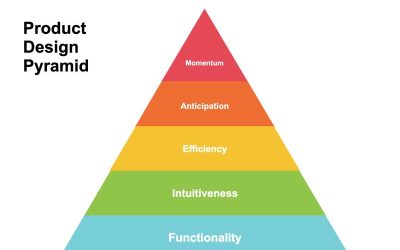Customer research is fundamental to the design process. It’s been well established that relying on assumptions alone leads us to make biased decisions that often fail to reflect the reality of the customer’s needs and wants, leading to poor results (including reduced revenue).
Basically, it’s more expensive to skip the research than it is to do it.
This principle isn’t specific to design. Management consultant Peter Drucker famously said that “If you can’t measure it, you can’t manage it.” The concept wasn’t new to him, of course. It’s the same basic idea conveyed in the old English proverb “Measure twice, cut once,” and is a sentiment that’s been expressed in countless ways by countless people over the years.
So why does research make people so nervous? Customer research—arguably the very foundation of the entire design process—is often the first thing companies want to skip.
If you don’t do the research, everything that follows in the design process is basically being done while wearing a blindfold. It devolves into guesswork. It’s not user-centered, customer-centered, human-centered design if you’re afraid to talk to the people that will actually be affected by it.
In my experience, I’ve noticed three main reasons why companies shy away from customer research:
- the fear of customer agitation
- the fear of ugly answers
- the fear of spending money
(…and if I knew enough Greek to translate those into cool-sounding phobias, I certainly would.)
The Fear of Customer Agitation
The first (and possibly most common) reason companies shy away from research is that they’re worried that asking such questions of their customers will stir up trouble.
In a situation where we’ve been hired to consult on a company’s internal brand/culture perceptions, for example, the executives might be concerned that asking the staff questions about their frustrations, concerns, hopes, impressions, etc., would only serve to remind them about how bad their current company culture is, and risk further lowering morale.
Think about this for a minute, though. If you’ve ever been in a company that had a dysfunctional culture, were you oblivious to it until someone pointed it out? And would you consider the management team asking questions about it to be a negative sign?
I’m guessing your answer is probably “no” to both of those. More likely, you were acutely aware of those issues every day, and seeing questions being asked might at least give you a ray of hope that some improvement might be on the horizon.
Similarly, it’s common for us to be hired by digital product companies to overhaul the user experience of a web or mobile application. When we ask to start with interviewing actual users, though, the client often gets nervous and eventually explains that they don’t want to draw attention to the existing clunky interface because it might reduce the user’s satisfaction level.
Again, I’m guessing you’d answer “no” if asked whether you’d be surprised to find that the outdated piece of software your company requires you to use is actually really frustrating. You already know it is. You shake your fist at it every day. Would you be even more frustrated if someone asked you some questions about it? No, probably not. You’d be glad that some action is being taken. It might actually buy some time before you snap entirely.
Generally, speaking, you’re not going to agitate your customers by asking questions about how you can make their lives better. This step not only gives you vital information, but it can actually help customer feel more confident that change is on the way.
The Fear of Ugly Answers
Human beings excel at avoiding bad news. We skip our annual checkup because we know the doctor’s going to tell us we’re eating too much and not exercising enough. We skip a popular documentary on Netflix because we think it might challenge our existing political or philosophical views. When our boss postpones our annual review, we’re secretly relieved because we didn’t want to see our own shortcomings laid bare.
Similarly, companies typically hire us because they’re in a sub-optimal situation, but they resist the idea of finding out exactly how bad it really is, often because they’re worried about how it’s going to reflect on them individually. The developer doesn’t want to hear that the slow page load times are killing their conversion rate. The marketing director doesn’t want to hear that they’ve had their messaging wrong this entire time. The CEO doesn’t want to know that the company’s been projecting the wrong image under her watch.
Nobody wants to look bad. Nobody wants to lose face. Nobody wants be embarrassed. So we take the obviously-wrong but still tempting path of dodging the bad news.
It’s not uncommon for a client to ask us, “We already know it’s a problem, so why do we have to dwell on it?” and “Can’t you just get started on making it better without making a big deal of it?”
The reality is that they probably got themselves into those unfortunate situations in the first place by failing to ask the relevant questions, and being willing to wrestle with the ugly answers.
(A variation on this situation comes up when someone is launching a new business idea. They’re so hopped up on adrenaline, passion, determination, and zeal that it would never occur to them to wonder if there might be problems with their concept. They just know it’ll work—and they don’t want to hear anyone suggesting anything to the contrary. It would be almost insulting to them for us to ask users if the product actually solves their needs. I’ve watched a lot of startups fail over the years because they literally never talked to a single potential user before jumping right into the design and engineering stages.)
Good design happens when it’s based on a firm foundation of reality, even an ugly reality, rather than prettied-up assumptions or fantasies. If you’re climbing a mountain, you have to put your foot where you know there’s a real foothold, not where you hope there’s one or think there might be one. It’s not worth the risk of stepping wrong and falling all the way down.
The Fear of Spending Money
This one is a lot more straightforward, of course. Sometimes companies just don’t want to pay for research, which they might see as a fluffy time-waster that’s only delaying the “real” work of creating something. After all, if you cut research out of the project, that’s going to save time and money, right?
As humans, we tend to only really pay attention to what’s right in front of us. Because of this, the money we already have seems infinitely more valuable than the money we don’t yet have. It’s called the endowment effect, and it’s one of the weirder cognitive biases going on in our heads all the time.
This principle messes with our mental math such that we’d often rather leave $100 on the table rather than risk spending $10 of the money we already have in order to get it.
As designers, we routinely see how the insights gleaned from effective user research make a significantly impact on the success of a company, product, or service. It happens all the time, it’s well-documented, and it’s second-nature to us. However, for those not familiar with the benefits of research as a fundamental part of the design process, it can feel like it’s just a waste of time. No matter how many case studies we provide about results we’ve generated for our clients, how many experiment write-ups we show them, how clear the evidence is that user research can result in significant additional revenue, it’s shockingly difficult to get people over the endowment effect. They just don’t want to give up any of the money they have now, even if it could result in significantly multiplying the results of a design project.
Nearly every effectively-designed product you use regularly was based on insights gathered from research, because design-savvy companies consider research to be fundamental to the design process. They love it. They’re happy to spend money on it, because they know it multiplies their revenue.
In order for a company to generate a really remarkable experience for their customers, they have to overcome their fear of investing in research. Yes, it costs money. Yes, it takes time. But we don’t do it for fun. We do it because it creates a significant improvement in the actual measurable results of almost any design project.
The Insight Addiction Trap
All this said, it’s still certainly possible to have too much research.
That sounds a little crazy, right? How can you have too much?
It becomes too much research when we’re wasting time going down rabbit holes that won’t actually make a significant difference in the project outcomes. It would be easy to conduct endless follow-up studies, interview yet more customers, spend more time analyzing the subtleties of user interactions, etc.
Every insight we gather about customers gives us a little burst of happiness, like winning $5 in the lottery. However, it’s essential to know how much research is enough, and when to cut ourselves off.
Effective user research should be tight, compact, and efficient. It should be approached almost like a special forces operation, where we get in, get the job done, and get out with minimal noise being made.
There are a lot of creative, cost-effective, and time-conservative ways to research users, and finding the right combination of techniques to get the information necessary in a prompt and reasonable way is part of the magic that makes user research work well. Sometimes even secondary research can provide enough insight to make a major difference.
However, there’s almost never a case where it makes sense to eliminate the research phase entirely, simply because it’s so fundamental to the design process. Even when a company is concerned about going overboard, it still makes sense to ensure that there’s some reasonable amount of research established in the project scope.
You’ll Thank Yourself
Have you ever heard anyone say “I wish we’d just gone with our assumptions instead of wasting our time studying the problem”?
Neither have I. However, I often hear people lamenting having moved forward without having done adequate research first. There are stories. Sad, sad stories. Failed products. Failed companies. Bankrupted individuals. It’s not pretty.
User research can make or break your project. Even if the service or product itself is so good that it gets traction without performing user research, still doing the research could make it significantly more successful.
It’s natural to have the fears described above. I hear them from our clients on a regular basis. But success in business takes bravery, and bravery is about doing what you need to do even when you have fears.
User research is one of those things you need to do, even if you fear it.










